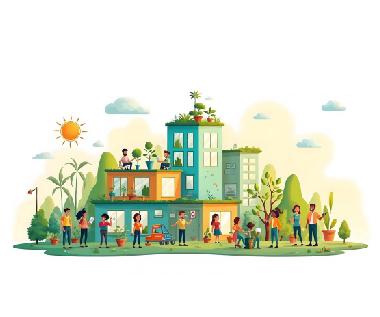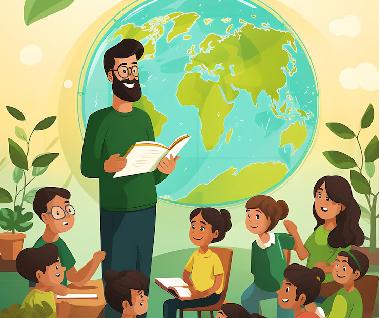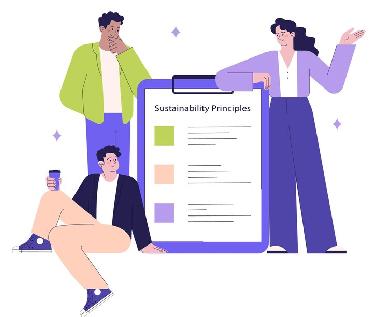Constructing the Education and World of the Future: Sustainable development is likely the largest challenge of the modern era that touches every corner of society. Education, as an active force of shaping the future, also plays a crucial part in shaping a sustainable future and a generation that is competent enough to face the bitter reality of climate change, resource limitations, and social disparities. Schools, being an influential institution, possess the unique opportunity of taking the concepts of sustainability into students' lives and hence making educational sustainable development an imperative of the 21st century
 What is Sustainable Development in Schools?
What is Sustainable Development in Schools?
Sustainable school growth is the integration of sustainability into the curriculum, campus life, and student activities. It means equipping students with knowledge, skills, and values to create a better world. Schools that aim for sustainable development emphasize educating students on how their actions impact the environment, economy, and society and how to make decisions that result in long-term gain for all.
Integrating sustainability into learning transcends the mere process of learning for nature conservation. It deals with questions of economic sustainability, social justice, and preservation of culture in its pursuit of achieving an integrated knowledge about how human beings can coexist in symbiosis with the environment and with one another. Through integrating these values into the day-to-day life of schools, students evolve with a sensibility that exceeds the boundaries of the school, influencing their attitude and conduct for the rest of their lives.
Education for Sustainable Development (ESD)
Education for Sustainable Development (ESD) offers theframework through which sustainability can be integrated in practice in education. ESD is meant to promote critical thinking and creative thinking, problem-solving skills that will empower learners to make contributions towards a sustainable future. The United Nations (UN) appreciates ESD as belonging to the entire agenda to support the Sustainable Development Goals (SDGs), which will assist in eliminating poverty, inequality, climate change, and peace.
which sustainability can be integrated in practice in education. ESD is meant to promote critical thinking and creative thinking, problem-solving skills that will empower learners to make contributions towards a sustainable future. The United Nations (UN) appreciates ESD as belonging to the entire agenda to support the Sustainable Development Goals (SDGs), which will assist in eliminating poverty, inequality, climate change, and peace.
At school level, ESD is not just the transfer of information regarding sustainability; it also becomes linked to the creation of values such as respect for nature, other culture empathy, and the sense of social responsibility. ESD transforms students' thinking about the world and makes them solution finders who seek solutions to the real problems of the world. It empowers young minds to become future leaders in creating sustainable societies and a world for future generations.
The Role of Sustainable Development in Schools
 Not only does sustainable development find a place, but also a vitally significant role in schools, and that is not merely a matter of incorporating matters of sustainability in the curriculum, but establishing a school culture that sustains such values in every aspect of life. Some of the most important places where sustainable development is a major consideration in schools are outlined below:
Not only does sustainable development find a place, but also a vitally significant role in schools, and that is not merely a matter of incorporating matters of sustainability in the curriculum, but establishing a school culture that sustains such values in every aspect of life. Some of the most important places where sustainable development is a major consideration in schools are outlined below:
Curriculum Development: Sustainability is initiated at school through incorporating ideas of sustainability into the curriculum. Science can be utilized in order to introduce climate change, renewable resources, and ecosystems, and social studies can address economic disparity, global justice, and fair trade. Students can learn the history of sustainable development, challenges to it, how the world evolved as it has and how things can be done in order to reverse it.
Campus Operations: Institutions can introduce a change by adding green practices to the campus. They include energy efficiency, reducing waste, conserving water, and using environmentally friendly products. Institutions, for example, can provide solar panels, utilize LED lighting, encourage recycling, and provide incentives to utilize public transportation or bike to the institution. This provides the students with a practical, hands-on learning experience and enables them to see that sustainability is not just theory but something that can be applied in their day-to-day life.
Community Involvement: Sustainability in schools is also practiced on a wider level in the surrounding community. The school may collaborate with the neighborhood associations, local government, and local businesses and encourage the construction of sustainability ideas in the area. The cleanup drives of the environment, tree planting, and hunger, poverty, and inequalities social initiatives can be harnessed for student involvement. With these activities, civic involvement among students can be promoted along with showing that students can make their impact.
Behavioral Change: Schools have the ability to make the students change their way of living to a more sustainable one through learning and active engagement in sustainability-related activities. Through the act of switching off lights, conserving water, green purchase choices, or advocating for policy changes, what is achieved at school translates to their everyday lives. This act creates a ripple effect that leads to long-term social and cultural change, culminating in sustainability on a global scale.
Global Perspective: School sustainable development makes students embrace a global perspective which takes cognizance of the fact that all challenges we are facing are interconnected. For instance, global warming in one part of the world will snowball in another place, and social injustice causes environmental degradation. Once students learn these issues at school, they become globally aware and empathetic in issues as a result, leading to a humane and collaborative approach towards problem-solving.
Sustainable Development Goals (SDGs)
United Nations' 2015 Sustainable Development Goals (SDGs) is ablueprint for addressing global issues. There are 17 SDGs, which include objectives of ending poverty, achieving gender equality, accessing clean water and sanitation, and combating climate change forthwith. Education for sustainable development is central to goal realization, as it enlightens one to act in a manner that promotes the realization of the goals.
addressing global issues. There are 17 SDGs, which include objectives of ending poverty, achieving gender equality, accessing clean water and sanitation, and combating climate change forthwith. Education for sustainable development is central to goal realization, as it enlightens one to act in a manner that promotes the realization of the goals.
Schools also have a fundamental role in advancing SDGs both in the school curriculum and as direct intervention. Most schools around the globe already incorporate the SDGs into daily activities. Schools can, for instance, include lessons on sustainable energy, social justice, or ethical consumption and offer learners arenas to carry out activities towards such goals.
By educating a generation that is familiar with the SDGs and motivated to act, schools contribute their share in global endeavors towards their accomplishment by 2030. Not only do they learn about the goals themselves, but they also learn how to implement sustainable solutions on local, national, and international scales.
There are various solutions that can be incorporated by schools to guarantee sustainable development. Some innovative ideas include:
Green Buildings and Alternative Energy: Schools can achieve carbon neutrality by constructing green buildings with efficient energy designs. Solar power, wind energy, and rainwater collection can be used to render schools energy and water self-sufficient.
Sustainable Food Practices: Schools can facilitate agriculture sustainably in such a manner that they have locally sourced organic food available in canteens, prevent food waste, and inform students about sustainable consumption.
Waste Reduction Programs: Schools can participate in waste reduction programs such as composting food scraps, reducing the use of plastic, and promoting the use of reusable products. Students can be involved in the performance of waste audits and designing awareness programs.
Green Classrooms: Incorporating more nature within the classroom environment, such as working with natural light, developing indoor gardens, and using eco-materials to decorate the classroom, can promote more contact with nature.
Conclusion
 Green school development is not just a passing fashion phenomenon but an important task to shape education and the future world. Sustainable education or education for sustainable development (ESD) helps in bringing up a new generation of students, not just educated and aware but more so motivated to bring about change upon those environmental problems under their presence. By integrating green practices in school operations, pedagogy, and engagement with society, schools also join the larger goal of a sustainable world. The future before us clearly indicates sustainable school development as a necessary requirement, not a nice luxury, to have a healthy world for current and future generations.
Green school development is not just a passing fashion phenomenon but an important task to shape education and the future world. Sustainable education or education for sustainable development (ESD) helps in bringing up a new generation of students, not just educated and aware but more so motivated to bring about change upon those environmental problems under their presence. By integrating green practices in school operations, pedagogy, and engagement with society, schools also join the larger goal of a sustainable world. The future before us clearly indicates sustainable school development as a necessary requirement, not a nice luxury, to have a healthy world for current and future generations.

